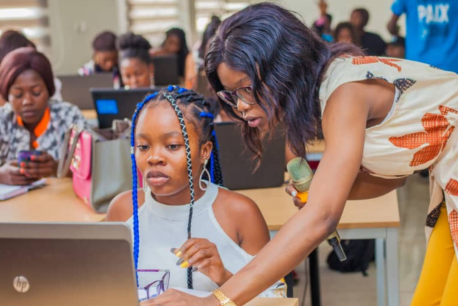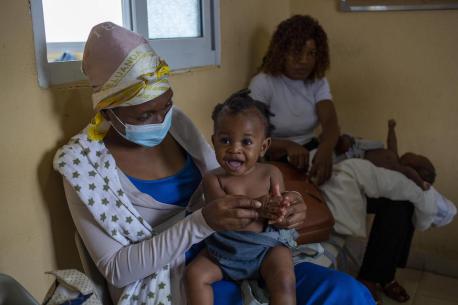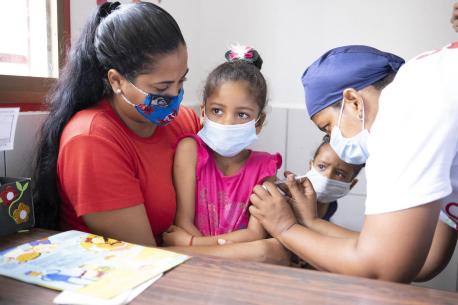
Record Number of Children in Crisis, Says UNICEF's Humanitarian Appeal
UNICEF launches $9.4 billion emergency funding appeal for the 177 million children affected by conflict, the climate crisis and COVID-19.
Since the early days of the COVID-19 pandemic in December 2019, the needs of children already living in dire conditions have grown increasingly urgent. The world is confronting an unprecedented child rights emergency, with the converging forces of poverty, inequality, climate change, conflict and COVID-19 undoing decades of progress.
In response, UNICEF has launched a $9.4 billion emergency funding appeal — 31 percent larger than last year’s — to reach more than 327 million people, including 177 million children, affected by humanitarian crises and the COVID-19 pandemic worldwide.
“Millions of children around the world are suffering from the impacts of conflict, extreme weather events and the climate crisis,” said UNICEF Executive Director Henrietta Fore. “As the COVID-19 pandemic approaches its third year, the plight of these children is made even worse with faltering economies, growing poverty and rising inequality. As always, it is the children already living through crises who are the hardest hit. They need urgent help.”

In Kandahar, Afghanistan, a young girl stands in the waiting room at the UNICEF-supported Mirza Mohammad Khan clinic. Outbreaks of measles, dengue fever and acute watery diarrhea continue to plague children and overwhelm struggling health services. Over 1 million children are at risk of death due to severe acute malnutrition. © UNICEF/UN0562569/Romenzi
As UNICEF turns 75, humanitarian needs have never been more pressing
In UNICEF's 75-year history, the humanitarian needs have never been more pressing. UNICEF's response efforts remain dangerously underfunded.
To guarantee the next generation a better life, UNICEF urgently requires timely, predictable and flexible funding — core resources not tied to a specific country or issue. This is essential to save children’s lives, preserve their dignity and protect their futures. With UNICEF’s staff and global national partners innovating and transforming the humanitarian landscape, there is cause for hope.
Thanks to generous donor funding in 2021, UNICEF and partners have responded to a complex set of overlapping crises. Over the year, continuing pandemic-induced service disruptions and economic decline upended child health and well-being. The world’s worst humanitarian crises for children — in Afghanistan, Yemen and Syria — further deteriorated, and escalating conflicts pushed millions more children and their communities into desperate situations. Attacks on children and the infrastructure critical for their survival continued at an alarming rate while climate change exacerbated the scale, frequency and intensity of emergencies. More children are now on the move than ever before.
In addition to responding to those emergencies, UNICEF has played a crucial role in the UN-wide COVID-19 response through the procurement and supply of over 600 million COVID-19 vaccines through the COVAX facility, the largest vaccination campaign in history. UNICEF also procures and transports immunization supplies such as syringes, safety boxes for their disposal, and cold chain equipment such as vaccine refrigerators. Throughout the pandemic, UNICEF has ensured the safety of the public and health workers through education, advocacy and delivery of PPE, oxygen concentrators and other supplies.
Below, a look at how UNICEF programs improved the lives of vulnerable children in the first eight months of 2021, and a preview of how that impact will continue in 2022 with the crucial support of donors.
An increasing number of children are being treated for severe acute malnutrition

A mother cares for her severely malnourished baby at a UNICEF-supported stabilization unit in Ayder hospital in Mekelle, the capital city of the Tigray region in Ethiopia. Due to the conflict, UNICEF estimates that over 100,000 children in Tigray could suffer from life-threatening severe acute malnutrition over the next 12 months. ©UNICEF Ethiopia/2021/Esiey Leul
Children who don't get the essential nutrients they need to grow and develop properly experience lifelong challenges.
Since military clashes erupted late last year in Northern Ethiopia, emergency levels of malnutrition and food insecurity have posed escalating threats to children. Although humanitarian access in and out of Tigray, and neighboring Afar and Amhara, remains challenging and unpredictable, UNICEF managed to screen and treat over 700,000 children for malnutrition in November alone.
In 2021, UNICEF and partners treated 2.4 million children around the world for severe acute malnutrition. UNICEF aims to reach 7.2 million more with lifesaving treatment in 2022.
Cash transfers allow families to set and act on priorities
Emergency cash transfer programs provide dignity and choice for vulnerable families, allowing them to buy food and medicine for their children and pay for their schooling and other essentials. In 2021, UNICEF provided 14.9 million people worldwide with cash assistance; in 2022, that number is projected to rise to 23.6 million.
Multiple studies in different parts of the world have shown that cash transfers can improve food security and increase the number of people accessing health services, immunizing their children and keeping them in school. In emergencies such as droughts, floods — and pandemics — cash transfers are considered one of the most effective ways to support families because no one knows better what children need than their parents. With a lump sum, caregivers can purchase food, medicine, clothes and shelter as required.

Despite her mother Tereyian’s (above left) determination not to marry her off, 16-year-old Nashipae was afraid she might have no other option as the pandemic stretched on and the economy in her hometown Kajiado, Kenya, worsened. “I feared to be married off or forced into harmful cultural practices like FGM,” she says. A UNICEF program to alleviate families' pandemic-related financial pressure provided Tereyian a cash transfer that helped secure Nashipae's present and future. © UNICEFKenya/2021/Nyaberi
As widespread poverty due to COVID-19’s economic shocks gripped communities in Kajiado, Kenya, families began marrying their young girls off because they could no longer afford to keep them at home. Sixteen-year-old Nashipae feared that might become her fate when her family's financial difficulties grew more severe. But thanks to UNICEF cash transfers to families across Kenya, Nashipae is safe at home and in school, free to work toward living up to her potential.
“I want to be a doctor because I want to help my community and also to help the needy,” she explains. “I feel cared for and loved as my parents are supporting me in achieving my dream of being a doctor.”
Psychosocial support helps children and young people heal
In 2021, amid concerns over the COVID-19 pandemic's ongoing impact on children's mental health, UNICEF provided 5 million children and caregivers with mental health and psychosocial support.
But even before the pandemic began, children and young people in many parts of the world faced constant assaults on their mental health and well-being. Especially vulnerable are the millions of children who are forced from their homes by conflict and severe adversity each year. Deprived of schooling, protection and support, children and young people on the move bear mental scars that can cause pain long after their migration journeys end.
In Barcelona, Spain, a unique UNICEF-supported program has been helping migrant children and teens, some unaccompanied, cope with the memories of what drove them from home and what they endured during their journeys. Supported by Spain’s UNICEF National Committee and local and regional authorities, the Transcultural Mental Health Program addresses the marginalization, domestic violence, abuse and neglect many young migrants have experienced and helps them adjust to their new lives.
“Each person is unique and has to be treated as such,” says the Transcultural Mental Health Program founder Francisco Collazos. Since 2001, his program has helped heal migrant children's and teens' anxieties, feelings of isolation and fear and helped them cope with the new struggles they face assimilating in their new homes.
In 2022, UNICEF aims to reach nearly 23 million children and young people around the world to help address the severe strain and psychological impact experienced by those living amidst crises.
UNICEF aims to deliver safe water for every child

After August’s earthquake in Haiti, UNICEF and partners installed water-treatment systems and trucked water into hard-hit areas to provide over 620,000 gallons of safe drinking water to children and families. © UNICEF/UN0521185/Ergen
In 2021, UNICEF and partners provided 34 million people with enough safe water for drinking, cooking and personal hygiene.
Growing up in a clean and safe environment is every child’s right. Access to safe water, basic toilets and education about good hygiene practices keeps children thriving and healthy. When disasters like the powerful earthquake that rocked southwestern Haiti in August strike, a rapid response is required to keep children safe. Within hours of the earthquake, UNICEF teams coordinated an immense humanitarian effort, beginning with the delivery of essential medical supplies to hospitals. In the following days, in addition to working to reunite separated children with their families, UNICEF worked with partners and national authorities to get water and hygiene supplies to communities that lost critical systems and infrastructure.
In the coming year, UNICEF plans to reach 53.4 million people worldwide with access to safe water for drinking and their household needs.
While the focus is on COVID-19, it remains important to keep diseases like measles at bay, too
In 2020, such UNICEF-supported measures as masking, handwashing, and distancing helped contain the spread of COVID-19 and other infectious diseases such as measles. Despite lockdown measures restricting immunization campaigns, measles cases dropped, but health officials warn against complacency.
“[E]vidence suggests we are likely seeing the calm before the storm as the risk of outbreaks continues to grow around the world,” Dr. Kate O’Brien, Director of WHO’s Department of Immunization, Vaccines and Biologicals, recently explained. “It’s critical that countries vaccinate as quickly as possible against COVID-19, but this requires new resources so that it does not come at the cost of essential immunization programs. Routine immunization must be protected and strengthened; otherwise, we risk trading one deadly disease for another.”
In Myanmar, where an unprecedented political crisis, COVID-19 and profound economic shock endanger the 5 million children now in need of humanitarian assistance, measles threatens to make a comeback. With the collapse of Myanmar’s health care system and disease prevention programs, a campaign to vaccinate nearly 1 million children this year against measles and other diseases never happened. UNICEF, which provides vaccines for the program, warns of deadly outbreaks in the coming months.
Myanmar isn't the only country where UNICEF is on alert. Alarmed by the 3 million increase in infants who missed their first dose of measles vaccine in 2020 — bringing the numer to 22 million — UNICEF is gearing up to vaccinate 62.1 million children against measles in 2022.
Children and women need to be protected from gender-based violence
In 2021, UNICEF reached 8.6 million women, girls and boys with gender-based violence risk mitigation, prevention or response interventions and 3.2 million people with access to safe channels to report sexual exploitation and abuse.
Gender-based violence is the most pervasive yet least visible human rights violation globally. Because migrant children and families are especially at risk, UNICEF operates child-protection programs along dangerous migration routes to help children stay safe and recover from the threats they experience along the way.

Nelda, from Haiti, reunites with her daughter, Neldaisha. The mother and daughter were crossing through the Darien Gap trying to reach Panama with Neldaisha’s father and sister when they got separated. Family friends took Neldaisha under their wing and brought her to a UNICEF-supported safe space, where she was cared for until her family was found. © UNICEF/UN0560258/Urdaneta
Crossings from Columbia to Panama through the Darien Gap are increasing at an alarming rate. One of the world's most dangerous migration routes, the Darien jungle, is the pathway 19,000 migrant children, half under age 5, have traversed so far this year, nearly three times more than the number registered over the five previous years combined. By year's end, Panama expects to receive nearly 150,000 migrants, including 30,000 children, and many of them will have been exposed to violence, including sexual abuse, trafficking and extortion.
Greeting those who make it across the border are the teams from UNICEF Panama and partners now providing psychosocial support and health services to children, especially those separated from their parents. Teams are also assisting in referring children who have experienced violence and sexual assault to local protection services.
In 2022, UNICEF plans to reach 21.3 million children and women with gender-based violence risk mitigation, prevention and response interventions.
UNICEF is helping all children everywhere learn
In 2021, UNICEF ensured that 110.7 million children could access formal or non-formal education, including early learning.
Among them are children and young people in Afghanistan who UNICEF is helping to overcome COVID-19 lockdowns and violence to exercise their right to learn. But when secondary schools in Afghanistan reopened in September after months-long COVID-19 closures, not all Afghani children made it to class. Even before Afghanistan’s most recent humanitarian crisis, 4.2 million children were not enrolled in school — 60 percent of them are girls. An additional 10 million students require education assistance.
For some time, UNICEF has worked with Afghanistan's Ministry of Education and other partners to support students and teachers, build better education systems, and create environments conducive to learning and development. That work will continue in 2022 in Afghanistan and worldwide as UNICEF aims to reach 77.1 million children with formal or non-formal education, including early learning.
Children's needs in nutrition are greater than ever
In 2021, 22.4 million children and women received essential health care services in UNICEF-supported facilities.
Those services are especially vital in Yemen, where the six-year civil war has left more than 2 million children under age 5 acutely malnourished. Today, Yemen is the most dangerous place in the world to be a child. A shocking 10,000 children have been killed or maimed since the fighting started in March of 2015. The protracted armed conflict has left the nation in ruins and left 70 percent of the total population, including 11.3 million children, in need of humanitarian assistance.

In the village of Wadi Habat, Yemen, community health worker Razaqah Ahmed Ahmed Haroon Habad goes door-to-door treating children suffering from malnutrition and disease. © UNICEF
Economic collapse and breakdowns in national systems and services that provide children's health care and nutrition are particularly devastating.
Stepping into the void are UNICEF-supported community health workers who go door-to-door, providing lifesaving nutrition support and health care. Razaqah Ahmed Ahmed Haroon Haban, a health worker in the village of Wadi Habitat, says she's grown accustomed to making repeat visits to children she's treated — first for one ailment, then another. "The impact of the conflict on children was the spread of diseases, malnutrition and the difficulty of recovering from diseases," she says. "Just as children start to get better, their health relapses again."
Although the program is underfunded and the pandemic has reduced the number of families she can visit safely in a day's work, this heroic health worker is but one of many who will continue to safeguard the lives of mothers and children in 2022 with UNICEF’s help. UNICEF plans to reach 745.1 million people in the coming year with campaigns to promote good health and disease prevention services to protect endangered children from Yemen and around the world.
TOP PHOTO: A 3-year-old boy is being screened for malnutrition as part of the out-patient therapeutic feeding program at the Dagon Seikkan ward community hall in Myanmar. © UNICEF/UN0556774/Htet
HOW TO HELP
There are many ways to make a difference
War, famine, poverty, natural disasters — threats to the world's children keep coming. But UNICEF won't stop working to keep children healthy and safe.
UNICEF works in over 190 countries and territories — more places than any other children's organization. UNICEF has the world's largest humanitarian warehouse and, when disaster strikes, can get supplies almost anywhere within 72 hours. Constantly innovating, always advocating for a better world for children, UNICEF works to ensure that every child can grow up healthy, educated, protected and respected.
Would you like to help give all children the opportunity to reach their full potential? There are many ways to get involved.





